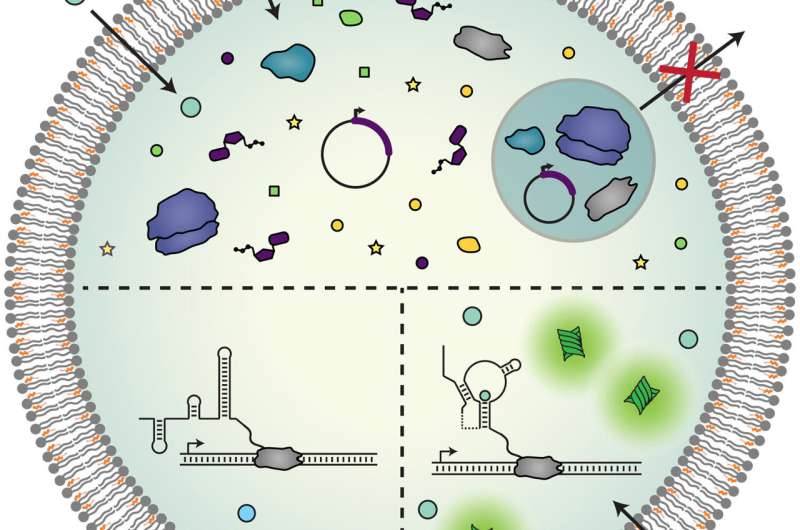This article has been reviewed according to Science X's editorial process and policies. Editors have highlighted the following attributes while ensuring the content's credibility:
fact-checked
peer-reviewed publication
trusted source
proofread
Researchers detect fluoride in water with new simple color change test

Environmental contaminants like fluoride, lead and pesticides exist all around and even within us. While researchers have simple ways to measure concentrations of such contaminants inside lab environments, levels are much more difficult to test in the field. That's because they require costly specialized equipment.
Recent efforts in synthetic biology have leveraged cellular biosensors to both detect and report environmental contaminants in a cost-effective and field-deployable manner. Even as progress is being made, scientists have struggled to answer the question of how to protect sensor components from substances that naturally exist in extracted samples.
A cross-disciplinary team of synthetic biologists at Northwestern University is developing a sensor platform that will be able to detect a range of environmental and biological targets in real-world samples. Using an established riboswitch to build a biosensor for fluoride, the team found they could both protect the sensor and operate similarly to the way cells do by encapsulating the sensor inside a fatty membrane.
In a new paper published in the journal Science Advances, researchers have demonstrated that by modifying the makeup and penetrability of the lipid bilayer membrane, they could further tune and control the performance of their sensor.
"So much data is being generated, and a lot of it is being driven by health apps like smart watches," said Julius Lucks, a co-corresponding author and professor of chemical and biological engineering at Northwestern's McCormick School of Engineering. "We can sense our heartbeat, our temperature, but if you think about it, we really have no way to sense chemical things. We're living in an information age, but the information we have is so miniscule—chemical sensing opens enormous dimensions of information that you can tap into."
Lucks is also the associate chair of the chemical and biological engineering department. His lab has advanced the field's understanding of molecular systems that respond to environmental changes by studying RNA and its role in cells; how RNA is used by cells to sense changes in their environment; and how these concepts can be used within cell-free systems to monitor the environment for health and sustainability.
Cell-free synthetic biology, in which engineered biomolecular systems are used to activate biological machinery rather than living cells, is compelling because it is efficient, versatile and low-cost. Lucks designed a riboswitch sensor using bacterial cell extracts to power gene expression reactions (including fluorescent RNA or protein that lights up in response to contaminants) that produce visual outputs cheaply and within minutes.
Neha Kamat, an assistant professor of biomedical engineering within McCormick and a co-corresponding author, originally met Lucks at their faculty orientation and was interested in his desire to expand access to information. Kamat, whose expertise is in engineered membranes and membrane assembly, wondered if she could make Lucks's test tube system better using a vesicle, a membrane with two layers.
"They're using RNA and its associated machinery to sense molecules in real water samples and generate meaningful outputs," Kamat said. "My lab works a lot with the lipids commonly used to encapsulate mRNA for drug delivery, with the goal of using these compartments to build more cell-like structures. We had the idea that we could protect Julius's switches and allow them to work in samples that might be kind of dirty with other contaminants, like a cell can."
Other researchers have tried to place a sensor inside a membrane, but the switch stopped working properly and produced a much smaller signal because it's difficult to fit everything within the small container and then scale it up. To overcome this, the team modified the genetic output in the sensor to amplify and color it, so it's visible by eye and "you don't need a fancy detector to do it," said Lucks.
Encapsulation and protection are important to the sensor to make it function in native environments, like a wastewater channel with lots of other contaminants to erode the switch. This would be an example of "distributed sensing," which could aid in fields from agriculture to human health.
The group came together more officially when they received Northwestern's Chemistry of Life Processes Institute's (CLP) Cornew Innovation Award by pitching their "potentially disruptive" idea to the CLP's advisory board.
Lucks calls this project a "jumping off point" from which they will be able to embed sensors into more materials, including "smart" materials that can change properties, as in biology.
"As synthetic biologists, one of our major themes is identifying challenges and looking to nature," Lucks said. "What is it doing already? Can we build off that and make it do more to meet our needs?"
Fluoride became an obvious choice because there's a natural RNA molecule that senses it, allowing the team to design a simpler mechanism. But in the future, Kamat and Lucks have high ambitions about where use of the sensors can expand.
For example, the sensors could flow through the human body to detect small molecules and biomarkers before the sensor is retrieved through urine or another passive method. It could also detect levels of nitrate in soil and aid in monitoring run-off. Beyond that, Lucks and Kamat are excited to see uses within materials science such as soft robotics, thinking about how to build something akin to a butterfly that smells through its feet.
More information: Margrethe A. Boyd et al, Robust and tunable performance of a cell-free biosensor encapsulated in lipid vesicles, Science Advances (2023). DOI: 10.1126/sciadv.add6605
Journal information: Science Advances
Provided by Northwestern University




















